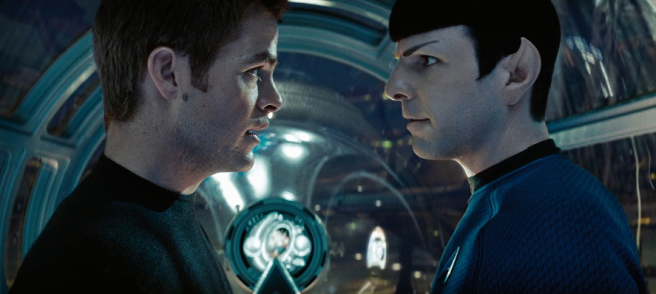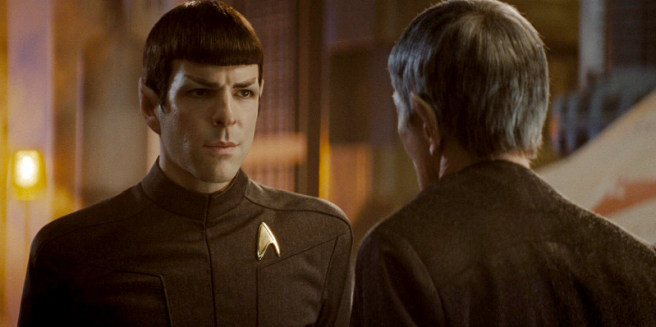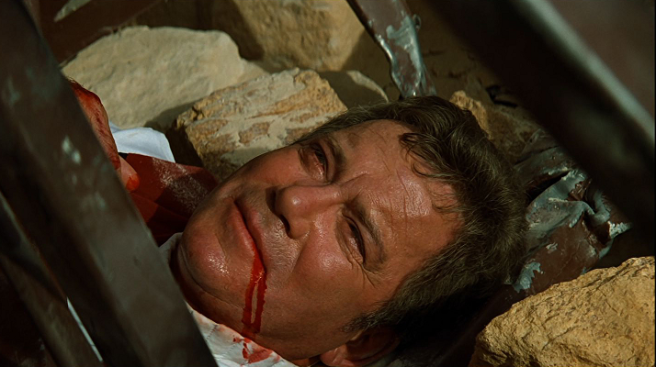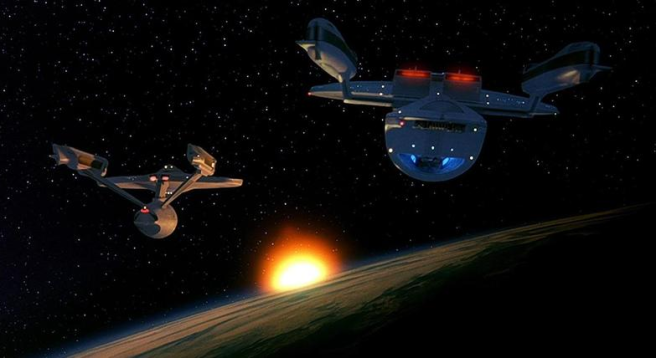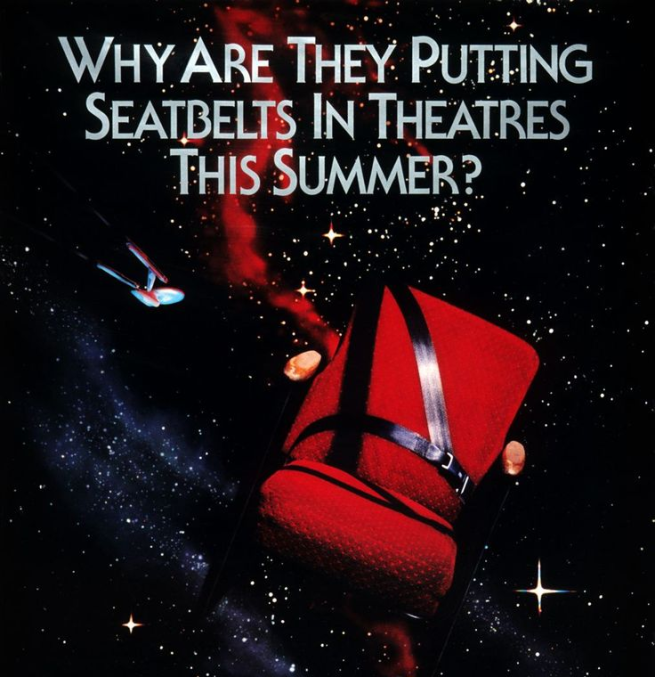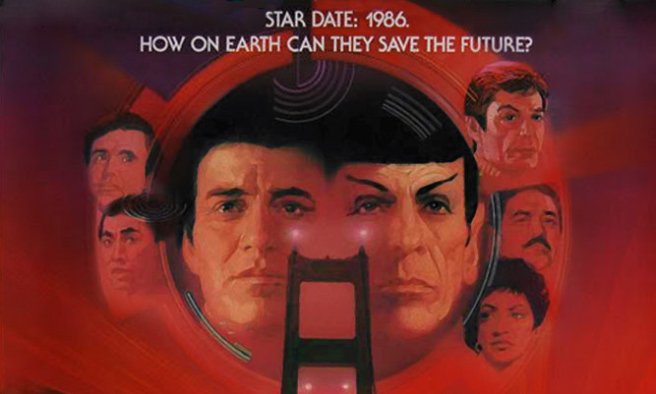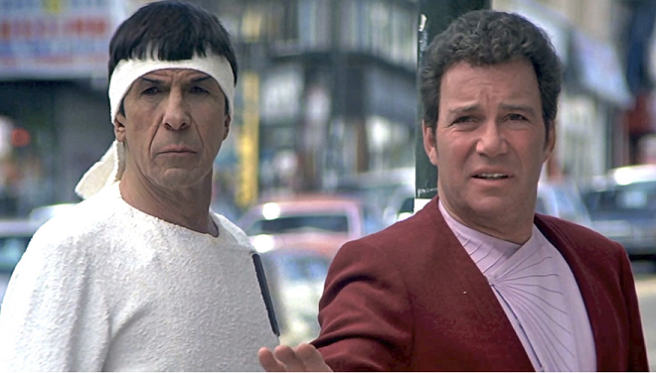
If there is to be an epitaph for the last two decades of filmed entertainment, it will be these two words: dark and edgy. I’m not sure you can pinpoint the precise date at which this era began: perhaps it coincides with the re-emergence of disaster movies in the mid-1990’s, followed by the tremendous downturn in the overall mood of the world since 9/11. Somewhere in there it became un-hip to look up, and nowadays, you need only tune your receiver to any given TV station to see programs filled with people doing horrible things to other people, whether it be on reality or on scripted television, and receiving accolades for it. The esteemed professional critics of our time are only too happy to initiate rounds of trained-seal clapping at the most violent and unpleasant pieces of fiction, and to wrench their noses disdainfully skyward at anything that suggests optimism and hope. I honestly don’t know whether this is our actual culture as a whole being reflected by our entertainment, or merely the small and insular cabal that produces that entertainment inflicting their inner turmoil on the rest of us. Perhaps it’s a bit of both; how else do you explain Donald Trump? But sensing the pervasiveness of the “dark and edgy” trend, I did roll my eyes a bit when the title of the twelfth movie in our ongoing series here was announced as Star Trek Into Darkness – a little on the nose, n’est-ce pas? Besides, Star Trek is supposed to be about looking to the future with anticipation that things are only going to get better. “Into Darkness” seems like the wrong course to plot.
With a quarter of a billion dollars in Paramount’s bank account as the lights went down on the final screening of Star Trek in 2009, questions about the content of an inevitable sequel to this suddenly-hot-again commodity began to simmer, but, strangely, they were singularly and somewhat simply focused: “Are you gonna do Khan? Huh? Are you gonna do Khan?” As much as we bemoan Hollywood’s tendency to repeat itself, those outside the bubble seem just as programmed to expect and even desire the recycling of their favorite hits. The Star Trek universe had been rebooted specifically to open up storytelling possibilities, not to churn out bigger-budgeted rehashes of what had gone before, and yet, here was the public almost daring J.J. Abrams and company to do just that. Ever the diplomats, and aware that every syllable of their responses would be parsed by fans eager to glean whatever hints they could, writers Alex Kurtzman, Roberto Orci and Damon Lindelof would make coy comments musing about how in this new continuity, Khan was out there in space in his sleeper ship, and it would be foolish to “not consider” using him. Privately, the writing team debated for over a year whether or not they wanted to shoehorn Khan into the screenplay they were crafting that was designed to confront Kirk and his crew with a threat to the fabric of Starfleet and the Federation itself. Responding somewhat to criticism that Kirk had been advanced too quickly to his captaincy in the previous movie, this story would see Kirk’s inexperience and impetuousness coming back to bite him.
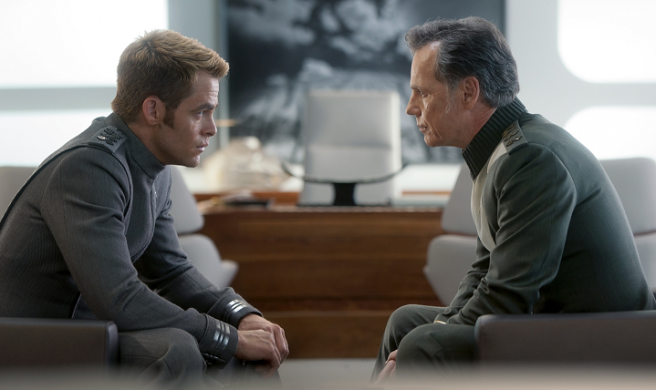
But to Khan or not to Khan? The former would immediately invite comparisons to the gold standard of Star Trek films; the latter, observed Lindelof, would be like Batman not using the Joker. So Khan it would be, but Abrams invoked his “mystery box” policy and clamped down on any mentions of the Enterprise crew’s most notorious foe, leading to what would turn out to be one of the most ineffective disinformation campaigns in the history of motion picture marketing. When Benicio del Toro was said to be in talks with the studio, only the least astute failed to note the similarity to Ricardo Montalban; when del Toro bowed out, additional Latino actors were considered, and everyone asked, “is it Khan?” Finally the very much not-a-Latino, but very much in vogue Benedict Cumberbatch was cast as this enigmatic bad guy, which allowed the Bad Robot team at least a modicum of deniability. The other actors weighed in on the is-he-or-isn’t-he debate as filming got underway: Simon Pegg called the rumored presence of Khan ridiculous, and Karl Urban blurted in an interview that Cumberbatch would be playing Gary Mitchell (Kirk’s best friend-turned-remorseless-godlet in Star Trek‘s 1966 pilot episode, “Where No Man Has Gone Before.”) A movie magazine ran a still from production in which Cumberbatch’s character was labeled as “John Harrison” – a bland, meaningless name intended to quiet rumors and creating quite the opposite effect. When Alice Eve was cast as “Carol Wallace” and Peter Weller as “Alexander Marcus,” it became fairly clear to all that some manner of retelling of The Wrath of Khan was afoot – even if the production crew remained adamant that Harrison was his own, unique man. They would stick to this attempted subterfuge until the middle of the movie’s second act…

On the primitive planet Nibiru, Kirk and McCoy are running from some angry aliens while Spock is lowered from a shuttle into a massive supervolcano on the verge of tearing the planet in half, and the Enterprise hides on the bottom of the nearby ocean. When Spock’s tether breaks and the shuttle can’t retrieve him, Kirk exposes the ship to the natives in order to beam Spock safely back, just before a “cold fusion” device detonates and renders the volcano forever inert. Nibiru is saved, but the natives begin worshipping the image of the Enterprise. Spock files a report criticizing Kirk’s decision – even if it was to save his life – and Starfleet strips Kirk of his command and reassigns him to the Academy. Admiral Pike tells Kirk that he does not “respect the chair,” and that such reckless behavior might one day lead to his entire crew being killed. Meanwhile, in London, a Starfleet officer with a dying daughter is approached by a deep-voiced stranger who promises a cure, which he supplies by way of a sample of his blood. The price is agreeing to carry out a suicidal terrorist attack – the bombing of London’s Kelvin Memorial Archive. A dejected Kirk is approached by Pike, who has spoken in his defense and gotten him reassigned to the Enterprise as first officer, under Pike himself. But the bombing in London necessitates an emergency meeting at Starfleet Headquarters in San Francisco, led by Admiral Alexander Marcus (Weller). Spock is also present, reassigned to the U.S.S. Bradbury under Captain Abbott. Marcus advises that the attack was carried out by one of their own: special agent John Harrison (Cumberbatch). He orders a massive manhunt, just as Kirk notices that Harrison is carrying something in the security footage of the bombing. Kirk recognizes that Harrison must have known that such an attack would precipitate a meeting like the one they are having now. Abruptly a Starfleet jumpship piloted by Harrison rises outside the window and strafes the meeting room with phaser fire, killing most of the senior personnel including Abbott and Pike. Kirk is able to disable the jumpship, but Harrison disappears in a transporter beam and materializes on a distant planet.
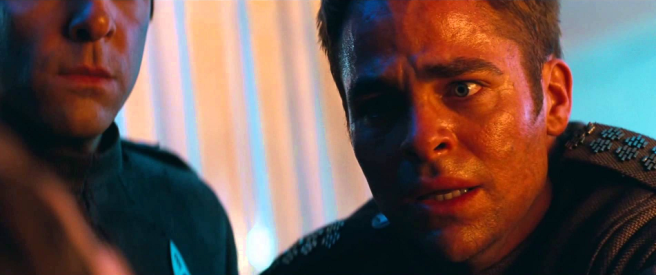
In the wreck of the jumpship, a portable transwarp beaming device is found, which Harrison used to escape to Kronos, the homeworld of the Klingon Empire – where Starfleet cannot follow. Admiral Marcus admits that the Kelvin Archive was cover for Starfleet’s intelligence unit, Section 31, which was researching advanced weaponry and tactics for an anticipated war with the Klingons. He gives Kirk the Enterprise, with Spock as his first officer, and orders him to hunt down and eliminate Harrison. He also equips the Enterprise with 72 special long-range torpedoes and assigns science officer Carol Wallace (Eve) to the crew. It’s an uneasy mission: Spock is uncomfortable with the idea of executing Harrison without a trial, while Scotty, who is unable to determine the armaments of the long-range torpedoes, resigns his post rather than sign off on permitting them aboard the ship, and cautions Kirk against ever using them. Kirk makes Chekov acting chief engineer and orders a course set for Kronos. Swayed by the arguments of his friends however, he advises the entire crew that their primary mission will be to capture Harrison, not kill him. Spock confronts Carol, telling her that he knows her real name is Carol Marcus, daughter of the Admiral, and questioning the purpose of her presence on the ship. Suddenly the Enterprise drops sharply out of warp; there is an unexplained coolant leak in the engine. Chekov gets to work on fixing it while Kirk, Spock, Uhura and a few security guys change into civvies and use a confiscated, non-Starfleet ship to finish the trip to Kronos, to ensure that the Federation cannot be held responsible for whatever happens next. Sulu, meanwhile, issues a message to Harrison, ordering him to surrender or be eliminated by the advanced torpedoes. Approaching Kronos, Kirk’s ship is ambushed by several Klingon vessels, and on the surface, Uhura, who speaks Klingon, tries to negotiate with their leader, who is uninterested in the internal disputes of humans and threatens to kill them. They are rescued by an unlikely savior – Harrison, who takes down most of the Klingon patrol with superior strength and fighting skills, before demanding to know just how many advanced torpedoes Kirk has. When he is told the number, he surrenders and is confined in the Enterprise‘s brig.

McCoy takes a blood sample from Harrison, who demands to speak with Kirk alone. He is aware of the Enterprise‘s engine trouble and gives Kirk a set of coordinates not far from Earth to investigate. He also suggests that Kirk open one of the torpedoes. Kirk contacts Scotty, who is sulking in a San Francisco bar, apologizes to him about the torpedoes and asks him to check out the coordinates. Scotty discovers a secret shipyard near Jupiter, and reacts with shock to what he sees. Since their message to Admiral Marcus indicating that Harrison has been captured has received no reply and the warp engines are still down, the Enterprise limps to a nearby planetoid where a torpedo can be opened safely without endangering the ship; Carol, whose true identity has now been revealed to everyone, volunteers to try with McCoy’s help. Inside the torpedo is a cryo-tube with a person frozen in it. Further examination reveals that the individual is 300 years old. Kirk demands answers, and Harrison is forthcoming: he is a genetically engineered human being from late 20th Century Earth, exiled with 72 of his crew into space aboard a sleeper ship that was found by Admiral Marcus after Vulcan’s destruction in the previous movie. Marcus woke him up to exploit his intellect and savagery in the design of weapons and ships to prepare for a war with the Klingons. Marcus also arranged for the sabotage of the Enterprise‘s warp drive, figuring that if a Federation starship fired torpedoes against the Klingon homeworld and was then found lurking in Klingon space, it would ignite the war he wanted. Harrison had hidden his crew in the torpedoes for their protection but thought they had all been killed, prompting his acts of terrorism. He adds that his real name is Khan.

Kirk has Khan moved to sickbay under guard, and the Enterprise is approached by a massive, sinister-looking starship: the Khan-designed, Dreadnought-class U.S.S. Vengeance, double the size and speed and weaponry of any other Starfleet vessel, and commanded by Admiral Marcus. When confronted with what Kirk knows, Marcus accuses Kirk of being influenced by Khan and orders that the renegade be executed. The Enterprise tries to escape at warp speed, but the Vengeance easily catches up with them and cripples the ship between Earth and its moon. Carol pleads with her father to spare the Enterprise, but he simply beams her aboard his ship and prepares to resume his attack, judging Kirk and crew in league with a terrorist and admitting he had always intended to destroy them. As Kirk looks despairingly at the faces of the crew he has seemingly led to their deaths – just as Pike predicted he someday would – the Vengeance‘s systems suddenly go offline. It’s Scotty, who managed to sneak aboard at the Jupiter shipyard and has now sabotaged the warship. They have a few minutes while the Vengeance reboots. Kirk asks for Khan’s help, claiming it’s the only chance he’ll have to save his own crew. McCoy, meanwhile, is further experimenting with Khan’s blood and injects it into a dead tribble to see what effects it might have. The Enterprise aligns its waste port with the Vengeance‘s airlocks, and Kirk and Khan leap across debris-filled space in thruster suits to reach the warship, reuniting with Scotty and proceeding to confront Admiral Marcus on the bridge. In the meantime, Spock, left in command of the Enterprise, makes a call to his older self (Leonard Nimoy in his last acting role before his death in 2015) to ask about Khan; Spock Prime reveals that Khan is the deadliest adversary that the Enterprise ever faced and that he was only defeated at great cost.

Spock orders McCoy to begin work on arming the torpedoes, and the Vengeance‘s systems come back online just as Kirk, Scotty and Khan reach its bridge, stunning everyone except the Admiral and his daughter. Scotty also stuns Khan. Kirk arrests Admiral Marcus, but Khan recovers from the stun and attacks them all, crushing the Admiral’s skull as Carol screams in horror. Khan takes command of the Vengeance and orders Spock to surrender the torpedoes containing his crew. Spock complies, beaming Kirk, Scotty and Carol back as the torpedoes are transferred to the Vengeance. But they unexpectedly detonate once they are onboard, damaging the Vengeance beyond repair and driving Khan into a blind rage. It turns out that Spock had all the cryo-tubes removed before beaming them over, and Khan’s crew is stored safely in sickbay. But the crisis is not over; the Enterprise‘s engines fail, and the ship is caught in Earth’s gravity and begins plummeting toward the planet. The warp core injectors are misaligned, and extreme radiation is saturating the chamber where they are located. Kirk knocks Scotty out, enters the chamber and kicks the injectors back into place, restoring ship’s power and pulling it out of its dive. Scotty calls the bridge and tells Spock to get down here, that he’d better hurry. Beyond the glass wall of the reactor chamber, Kirk is dying. He says he is scared, and asks Spock if he knows why he saved his life back on Nibiru. Spock says it is because they are friends. They press their hands against their respective sides of the glass, and Kirk slips away. Spock’s emotions overwhelm him and he screams Khan’s name.

Khan sets the crumbling Vengeance on a suicide run into Starfleet Headquarters in San Francisco, and the massive ship plows into the city, taking out several buildings (including Alcatraz Island) and probably killing thousands, though we never see that. Spock beams down to chase the genetic superman through the streets, and the two battle hand-to-hand on top of a flying garbage barge. Back on the Enterprise, the dead tribble McCoy had injected with Khan’s blood chirps to life, and they realize there is still a chance to save Kirk. As Spock and Khan fight, Uhura beams to the barge and stuns Khan, knocking him off balance and enabling Spock to get the upper hand. Spock begins pummeling Khan remorselessly until Uhura screams at him to stop, that Khan is their only chance to bring Kirk back. The Vulcan finally K.O.’s his opponent with one last belt to the face. Some time later, Kirk awakens in a hospital room, having been restored by an injection of Khan’s blood. Kirk thanks Spock for saving his life, and Spock reciprocates the sentiment. Khan is returned to cold storage along with his crew, and Kirk presides over the dedication of the rebuilt Enterprise, observing that Starfleet’s true mission has always been one of exploration and that they cannot be lured from that path by those who would seek to do them harm. Back on the bridge, Kirk orders the Enterprise to commence its five-year mission, with Carol Marcus as a member of the crew, and Spock finally expressing his trust in Kirk’s good judgment. Warp speed to credits.

Star Trek Into Darkness is perhaps the most overtly political Star Trek movie, simmering with hard questions about the role of principles, ethics and due process in an era of war against enemies that can rarely be seen or predicted. It asks whether we can remain true to who we are and the values we cherish, or if victory requires that we become what we despise. Unfortunately it buries these fascinating discussion points beneath a poorly constructed and far less effective karaoke version of The Wrath of Khan, with a climactic sacrifice undone before the end credits by means of magic blood. At every turn, punches are pulled; for a movie whose title boasts of a journey into darkness, the story really never has the guts to venture that far down the path. Who, in fact, is trekking into darkness? It’s not our guys, who largely resolve their ethical qualms in the first act. It’s more the Dick Cheney-esque Alexander Marcus, who sets the convoluted plot in motion for our heroes to untangle (and for Cumberbatch to explain mid-movie in an overly long expositional monologue), and who is merely the latest in a long line of Starfleet admirals who are corrupt/misguided/evil (curious in Roddenberry’s supposedly perfect future how the guys at the very top remain morons). Perhaps the only main character who dares explore his dark side is Spock, in what to me represents a fundamental misunderstanding of the character. This is two movies in a row now we’ve watched him lose his temper, but what made Spock special in the first place was his ability to make emotional and human choices from an unemotional, flawlessly logical perspective – not waiting to see what will make him fly off the handle and start throwing punches. When he gave of himself in The Wrath of Khan, he kept his emotions contained to the very end, suggesting that grief was unnecessary because his act was logical – the needs of the many outweigh the needs of the few. By contrast, Zachary Quinto’s Spock is always being driven almost exclusively by his emotions, and it betrays the mentality of the writers penning his lines, guys who are accustomed to painting in broad, easily understood by mass audience strokes rather than the more interesting nuances and subtleties that made up the Nimoy version of Spock.

Be that as it may, the main problem with Star Trek Into Darkness is that only half of it is a good movie. Its first hour is compelling as we are welcomed back to Abrams’ immersive, budget-busting worldbuilding and genuinely intrigued by the mystery of who this sepulchral-voiced stranger might be… and it finally goes off the rails when the camera tightens in on Cumberbatch as he hisses “my name… is… KHAN!” From there we can’t help but do exactly what the writers feared we would: compare to Nicholas Meyer’s Star Trek II. The writers do not help themselves in this regard either, by bringing in Nimoy’s third act cameo to evoke memories of that other movie just as we should be neck deep in this one. And then, restaging the entire climax of The Wrath of Khan beat for beat, with the roles of Spock and Kirk reversed and the dialogue echoing lines we’ve heard recited a thousand times before. If we’re going to be asked to take this as the movie’s most dramatic, emotionally impactful moment, we shouldn’t also be invited to wink and smile at the familiar at the same time. This is blowing the landing, big-time. When The Wrath of Khan came out, nobody knew whether Spock would come back; here, we know Kirk will make it because this series just started and Chris Pine has a three-film deal. It’s dancing on the border of “dark and edgy” but skipping hurriedly back because we don’t want to possibly leave a sour taste in anyone’s mouths. It also sets a dangerous precedent for future films, in that there is now a story mechanism available in this universe for resurrecting any character who happens to kick off during the adventure – just go dig up Khan again and help yourself to a pint of his O-neg.
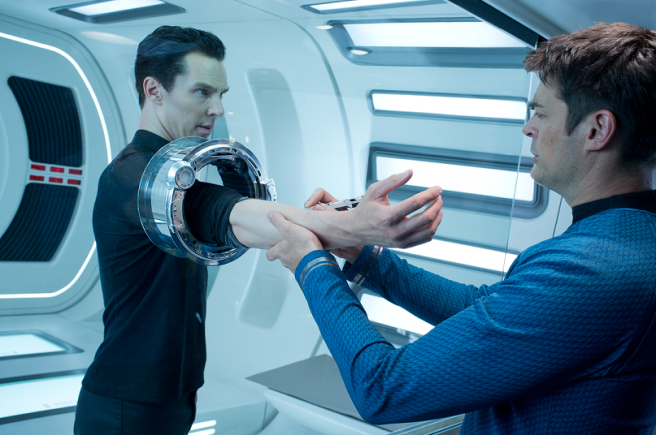
There are a few dumb moments that don’t help matters either: the Enterprise rising out of the ocean, Kirk in bed with two cat-tailed alien girls, the Beastie Boys again, and the much-maligned unnecessary shot of the lovely Alice Eve in her skivvies are products not of good storytelling instincts but of Red Bull infusions for bored writers thinking certain ideas would be “cool.” Some of the early plot twists don’t make any sense – I’m still not sure why, if Khan hates Marcus so much, he would retreat to Kronos of all possible forbidden locations throughout the galaxy (remember, space is really, really, really big) and give Marcus the perfect excuse to start his desired war with the Klingons. In fact, everything he does for the first hour seems to be helpfully furthering Marcus’ agenda, rather than trying to stop it. I can’t quite figure out the order of events following Khan’s waking either. He says Marcus held his crew hostage, but then Khan hid them in torpedoes, but only managed to get himself away, then thought Marcus had killed them all, then went rogue but was still able to meander about on Earth? Maybe there’s a piece I’m missing, but I shouldn’t have to think this hard to have things make logical – sorry – sense. As to the question of the caliber of the guy with the task of succeeding Ricardo Montalban as Khan, Cumberbatch is fine in this thankless assignment, and one supposes that it is a testament to his raw skill that he is able to speak a completely bewildering mid-movie monologue and still arrest your attention. He’s much less interesting when he’s required to growl and wince while he swings at Quinto – but then, action blockbusters have oft made fools of dignified Shakespeare-trained thesps, and Benedict Cumberbatch is not the first to succumb.

Sequels, especially first sequels in a franchise, are tricky work in that you have to do the same thing, but different and better. So much of the tank was obviously emptied for 2009’s Star Trek, because it was their one chance to do this universe over and set it up for a brand new generation of audiences. They had to leave it all out on the field. As a result, there did not seem to be much inspiration left for the second entry, necessitating the trip back to an old, much too familiar well. It would be one thing if The Wrath of Khan hadn’t been seen much since its initial release, but this is a modern sci-fi classic that is screened frequently every year, both in Trekkies’ home video collections and in revival houses across North America, its tropes seared into our pop culture collective consciousness. You don’t dare tamper with that unless you know you can knock it out of the park – and the best Star Trek Into Darkness can manage is a ground-rule double. It fails to get any further because it promises far more than it delivers, competently meeting expectations rather than thwarting them or surprising us. J.J. Abrams has said in hindsight that it was perhaps a mistake to hold back Khan’s identity in the marketing, given that the big reveal was ultimately a source of audience annoyance. But it never needed to have been Khan at all – the movie would have worked much better if Cumberbatch had played a completely original character in keeping with the freshness of this new direction. Recycling Khan, even if he is considered the Joker to Kirk’s Batman, brings nothing to the table. When he announces that his name… is… Khan, that’s for the benefit of us watching it, not for Kirk & company, who in this universe have never met him before and so the revelation within the story is meaningless. (I was watching the movie hoping that he wouldn’t say it, and when he did, my enthusiasm for the remainder of the movie ebbed like air silently escaping from a balloon.) And Spock yelling out his name in agony is not an earned, honest character moment, but a laughable callback to one of the most comic examples of William Shatner’s famed overacting. Montalban’s Khan had a history with Kirk, but this version of Khan is a forgettable villain-of-the-week, provided with just about as much depth and having as little lasting impact. Though the end sees him stored away for possible future revivals, I very much doubt we’ll be seeing him again.
The challenge for Star Trek Beyond will be to look forward and up once more, to put the lie to the notion that everything has to be dark and edgy to be accepted in this day and age. The trailers seem to foretell the opposite: a wrecked Enterprise, a lost crew, and a sneering bad guy promising death and destruction (and more Beastie Boys… sigh). But that doesn’t mean that the movie itself won’t contain what we need it to: hope, rising from the ashes of ruined starships.
I’ll check it out at the theater and let you know.
In summary: The non-Wrath of Khan parts are good. The Wrath of Khan parts are bad. Magic blood should never be spoken of again.
Final (Arbitrary, Meaningless) Rating: 2 out of 4 stars.








